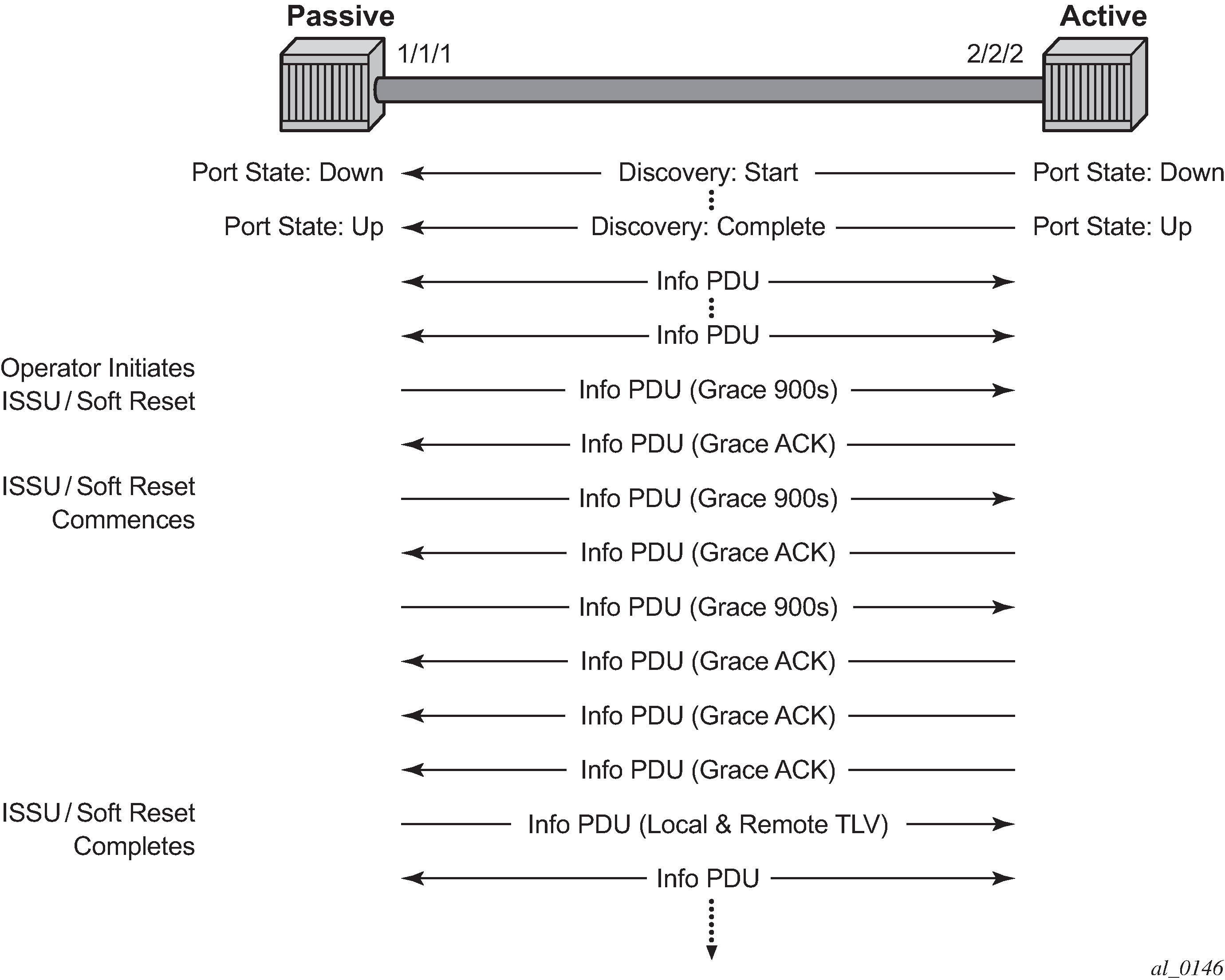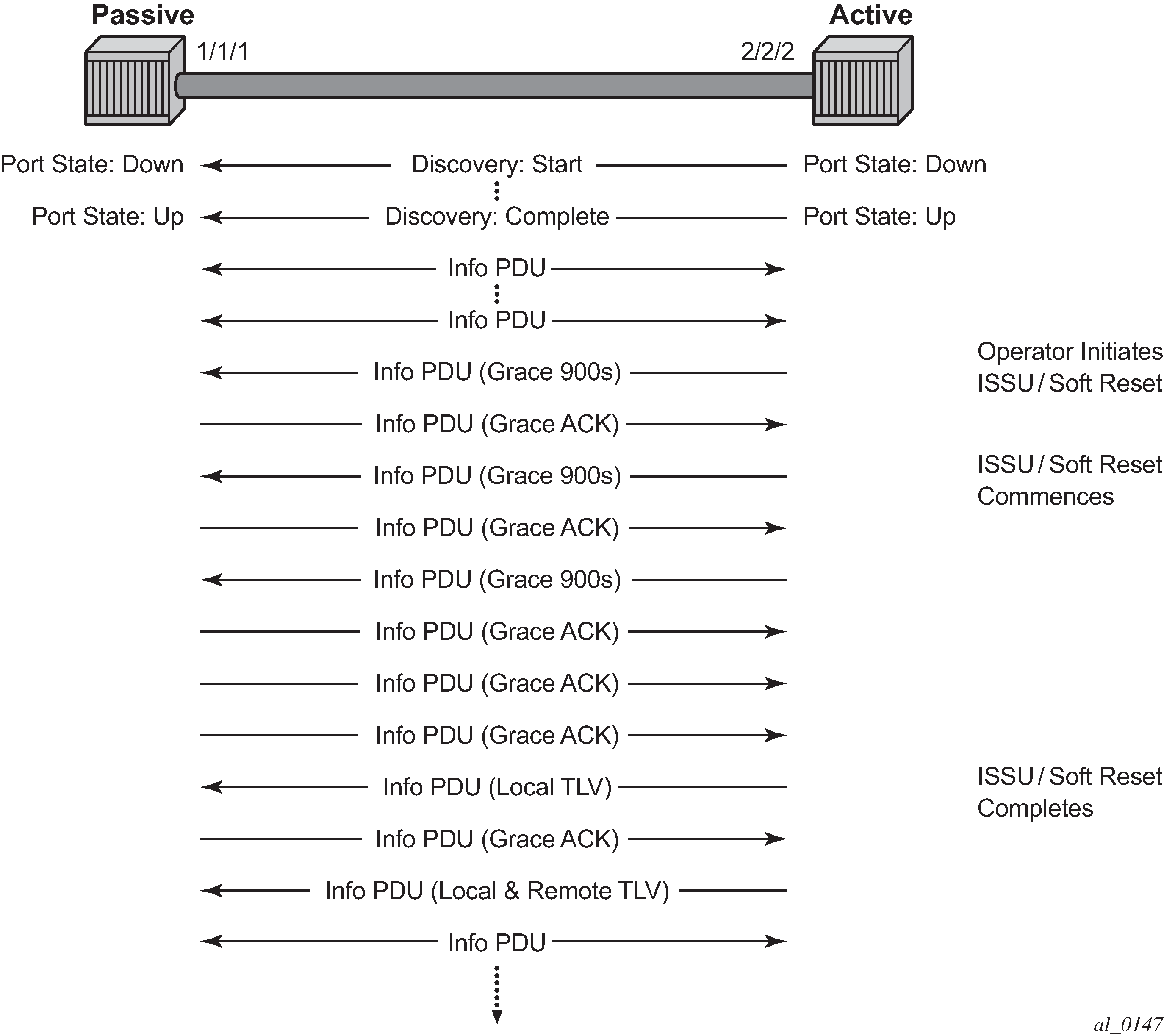The SR OS implementation of the EFM-OAM protocol supports vendor-specific soft reset graceful recovery. This feature is not enabled by default. It is configured using the grace-tx-enable command under the config>system>ethernet>efm-oam and the config>port>ethernet>efm-oam contexts. When this feature is enabled, the EFM-OAM protocol does not enter a non-operational state when both nodes acknowledge the grace function. The ports associated with the hardware that has successfully executed the soft reset clears all local and remote events. The peer that acknowledges the graceful restart procedure for EFM-OAM clears all remote events that it has received from the peer that performed the soft reset. The local events are not cleared on the peer that has not undergone soft reset. The Information OAM PDU Flag fields are critical in propagating the local event to the peer. The Event Notification OAM PDU, which is only sent when the event is initially raised, is not sent.
A vendor-specific Grace TLV is included in the Information PDU generated as part of the 802.3ah OAM protocol when a network element undergoes an ISSU function. Nodes that support the Soft Reset messaging functions allow the local node to generate the Grace TLV.
The Grace TLV informs a remote peer that the negotiated interval and multiplier should be ignored and the new 900s timeout interval should be used to timeout the session. The peer receiving the Grace TLV must be able to parse and process the vendor-specific messaging.
Use the grace-tx-enable command to enable this feature. This command exists at two levels of the hierarchy: system level and port level. By default, this feature is enabled on the port. At the system level, this command defaults to disabled. To enable this feature, both the port and the system commands must be enabled. If either is not enabled, the combination does not allow those ports to generate the vendor specific Grace TLV. This feature must be enabled at both the system and port level before the ISSU or soft reset function. If this feature is enabled during a soft reset or after the ISSU function is already in progress, it has no affect during that window. Both Passive and Active 802.3ah OAM peers can generate the Grace TLV as part of the informational PDU.
There is no CLI command to enable this feature on the receiving node. As long as the receiver understands and can parse the Grace TLV, it enters the grace mode of operation. The Nokia 7750 SR minimum release required to support the reception and processing of the Grace TLV is Release 11.0.R.4.
The following basic protocol flows demonstrate the interaction between passive-active and active-active peer combinations supporting the Grace TLV. In Figure 1, the passive node is entering an ISSU on a node that supports soft reset capabilities.

In Figure 2, the Active node is experiencing the ISSU function on a node that supports soft reset capabilities.

The difference between Figure 1 and Figure 2 is subtle but important. When an active node performs this function it generates an Informational TLV with the Local TLV following the successful soft reset. When the active node receives the Information PDU with the Grace Ack, it sends its own Information PDU with both Local and Remote TLV completed, which completes the protocol restart. When a passive node is reset the passive port waits to receive the 802.3ah OAM protocol before sending its own Information PDU with both the Local and Remote TLV, therefore completing the protocol restart.
The renegotiation process allows the node, which experienced the soft reset, to rebuild the session without restarting the session from the discovery phase. This significantly reduces the native protocol impact on data forwarding.
Any situation that could cause the renegotiation to fail forces the protocol to revert to the discovery phase and fail the graceful restart. During a Major ISSU when the EFM-OAM session is held operational by the Grace function, if the peer MAC address of the session changes, there is no log event raised for the MAC address change.
The vendor-specific grace function benefits are realized when both peers support the transmitting, receiving, and processing of the vendor-specific Grace TLV. In the case of mixed code versions, products, or vendor environments, a standard EFM-OAM message to the peer can be used to instruct the peer to treat the session as failed. When the command dying-gasp-tx-on-reset is active on a port, the soft reset function triggers ETH-OAM to set the dying gasp flag or critical event flag in the Information OAMPDU. An initial burst of three Informational OAM PDUs is sent using a 1-second spacing, regardless of the protocol interval. The peer may process these flags to affect its port state and take the appropriate action. The control of the local port state where the soft reset is occurring is left to the soft reset function. This EFM-OAM function does not affect local port state. If the peer has acted on the exception flags and affected its port state, the local node must take an action to inform the upstream nodes that a condition has occurred and forwarding is no longer possible. Routing protocols like ISIS and OSPF overload bits are typically used in routed environments to accomplish this notification.
This feature is similar to grace-tx-enable. Intercepting system messaging, when the feature is active on a port (enabled both at the port and at the system level) and when the messaging occurs, is a similar concept. However, because the dying-gasp-tx-on-reset command is not a graceful function it is interruptive and service affecting. Using dying-gasp-tx-on-reset requires peers to reestablish the peering session from an initial state, not rebuild the state from previous protocol information. The transmission of the dying gasp or the critical event commences when the soft reset occurs and continues for the duration of the soft reset.
If both functions are active on the same port, the grace-tx-enable function is preferred if the peer is setting and sending the Vendor OUI to 00:16:4d (ALU) in the Information OAM PDU. In this situation, the dying gasp function is not invoked. A secondary Vendor OUI can be configured using the grace-vendor-oui oui command, should an additional Vendor OUI prefer to support the reception, parsing, and processing of the vendor-specific grace message instead of the dying gasp. If only one of those functions is active on the port then that specific function is called. The grace function should not be enabled if the peer Vendor OUI is equal to 00:16:4d (ALU) and the peer does not support the grace function.
ETH-OAM allows the use of the trigger-fault {dying-gasp | critical-event} command to generate a fault condition. This sets the appropriate flag fields in the Information OAM PDU and transitions a previously operational local port to Link Up. Removing this command from the configuration stops the flags from being set and allows the port to return to service, assuming no other faults would prevent this resumption of service. In cases where a port must be administratively shut down, this command can be used to signal a peer using the EFM-OAM protocol, and the session should be considered failed.
These features do not support clearing of an IOM that does not trigger a soft reset. IOM clearing is a forceful event that does not trigger graceful protocol renegotiation.
The show commands are enhanced to help operators determine the state of the802.3ah OAM Grace function and whether the peer is generating or receiving the Grace TLV.
System level information can be viewed using the show system info command, as shown in the following example output.
show system information
===============================================================================
System Information
===============================================================================
System Name : system-name
System Type : 7750 SR-12
System Version : 11.0r4
System Contact :
System Location :
System Coordinates :
System Active Slot : A
System Up Time : 62 days, 20:29:48.96 (hr:min:sec)
…snip…
EFM OAM Grace Tx Enable: False
===============================================================================
The system-level EFM OAM Grace Tx Enable field displays one of the following two states.
False — The system-level functionality is not enabled. Grace is not generated on any ports regardless of the state of the option on the individual ports
True — The system-level functionality is enabled and the determination of whether to send grace is based on the state of the option configured at the port level
Individual ports also contain information about the current port configuration and whether the Grace TLV is being sent or received.
The port-level Grace Tx Enable field has two enable states with the current state in brackets to the right.
False — The port-level functionality is not enabled. Grace is not generated on the port regardless of the state of the option at the system level.
True — The port-level functionality is enabled and the determination of whether to send grace is based on the state of the option configured at the system level. The following applies:
(inactive) Not currently sending Grace TLV
(active) Currently sending the Grace TLV as part of the Information PDU
The port-level Peer Grace Rx field displays one of the following two states.
False — The port is not receiving Grace TLV from the peer
True — The port is receiving Grace TLV from the peer